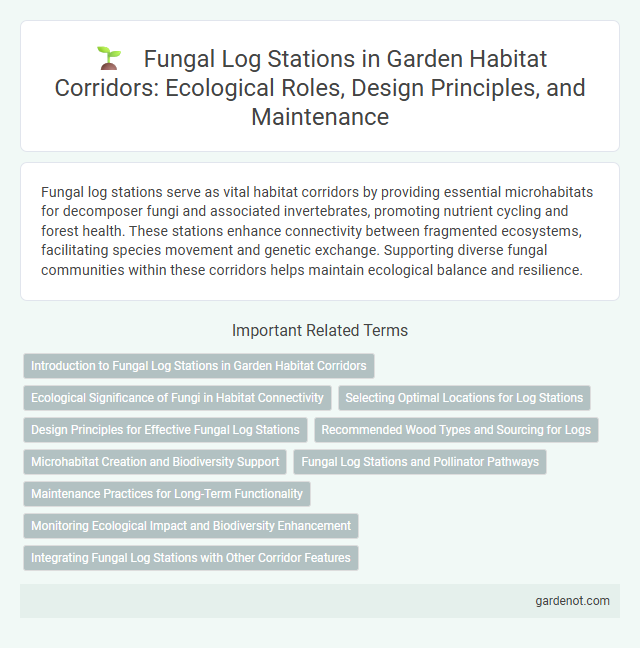Fungal log stations serve as vital habitat corridors by providing essential microhabitats for decomposer fungi and associated invertebrates, promoting nutrient cycling and forest health. These stations enhance connectivity between fragmented ecosystems, facilitating species movement and genetic exchange. Supporting diverse fungal communities within these corridors helps maintain ecological balance and resilience.
Introduction to Fungal Log Stations in Garden Habitat Corridors
Fungal log stations serve as vital components in garden habitat corridors by promoting fungal biodiversity and enhancing nutrient cycling within the ecosystem. These stations provide decaying wood substrates that support saprophytic fungi, which decompose organic matter and improve soil health. Incorporating fungal log stations in habitat corridors encourages symbiotic relationships with plants and contributes to ecological connectivity and resilience.
Ecological Significance of Fungi in Habitat Connectivity
Fungal log stations play a crucial role in habitat corridors by facilitating nutrient cycling and promoting soil health, essential for sustaining plant and animal communities. Mycorrhizal fungi establish symbiotic relationships with plant roots, enhancing water and nutrient uptake that supports vegetation continuity across fragmented landscapes. These fungi also contribute to decomposing organic matter, maintaining ecosystem resilience and enabling species movement through connected habitats.
Selecting Optimal Locations for Log Stations
Selecting optimal locations for fungal log stations enhances habitat corridors by targeting areas with high humidity, shaded canopy cover, and proximity to decomposing organic matter, which promotes fungal growth and biodiversity. Sites near water sources and undisturbed soil layers further support successful fungal colonization essential for nutrient cycling and ecosystem connectivity. Integrating geographic information system (GIS) mapping with field surveys assists in identifying microhabitats ideal for establishing fungal log stations within habitat corridors.
Design Principles for Effective Fungal Log Stations
Effective fungal log stations prioritize moisture retention and airflow by selecting partially decomposed hardwood logs placed in shaded, humid environments to optimize fungal colonization. Logs should be spaced with adequate gaps to prevent overheating and ensure spore dispersal while maintaining consistent humidity levels critical for mycelial growth. Incorporating fungal species-specific substrates and positioning stations near native fungal sources enhances biodiversity and supports ecosystem connectivity within habitat corridors.
Recommended Wood Types and Sourcing for Logs
Recommended wood types for fungal log stations in habitat corridors include hardwoods like oak, maple, and beech, which provide optimal nutrients and moisture retention for fungal colonization. Sourcing logs from sustainably managed forests or local tree removal services ensures ecological balance and reduces transportation emissions. Freshly cut logs with intact bark maintain ideal conditions for spore germination and mycelium development in fungal conservation projects.
Microhabitat Creation and Biodiversity Support
Fungal log stations serve as critical microhabitats, fostering diverse fungal communities that decompose organic matter and recycle nutrients within habitat corridors. These logs provide essential shelter and food resources for invertebrates, small mammals, and microorganisms, thereby enhancing overall biodiversity. The presence of varied fungal species also supports complex ecological interactions, promoting habitat connectivity and resilience.
Fungal Log Stations and Pollinator Pathways
Fungal log stations serve as critical microhabitats within habitat corridors, supporting diverse fungal species that enhance soil nutrient cycling and promote plant health. These stations also bolster pollinator pathways by providing essential resources and nesting grounds for pollinators like bees and butterflies, facilitating their movement and genetic exchange across fragmented landscapes. Integrating fungal log stations into pollinator corridors strengthens ecological connectivity and resilience in degraded ecosystems.
Maintenance Practices for Long-Term Functionality
Regular inspection and removal of debris are essential maintenance practices for fungal log stations within habitat corridors to ensure optimal fungal growth and spore dispersal. Maintaining adequate moisture levels and preventing contamination by invasive species help sustain the fungal community's health and functionality over time. Implementing periodic monitoring protocols supports early detection of disease or decay, thereby preserving the ecological balance crucial for effective habitat connectivity.
Monitoring Ecological Impact and Biodiversity Enhancement
Fungal log stations serve as critical monitoring points for assessing ecological impact by tracking fungal diversity and decomposition rates within habitat corridors. These stations enhance biodiversity by providing a substrate for symbiotic fungi, which supports soil health and nutrient cycling, crucial for plant and animal communities. Continuous data collection from fungal logs informs conservation strategies and the effectiveness of habitat connectivity efforts.
Integrating Fungal Log Stations with Other Corridor Features
Integrating fungal log stations within habitat corridors enhances ecological connectivity by fostering fungal diversity essential for nutrient cycling and soil health. These stations serve as critical habitats for mycorrhizal fungi, which establish symbiotic relationships with native vegetation, thereby strengthening plant resilience across fragmented landscapes. Strategic placement near water sources and wildlife pathways amplifies their ecological impact, promoting seamless species migration and ecosystem stability.
Fungal log station Infographic

 gardenot.com
gardenot.com